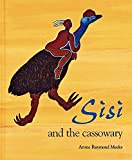Sisi and her family were bathing at a waterfall. Diving down to chase a tortoise, Sisi saw a crocodile and swam quickly away to safety. Safe from the crocodile she could not find her family and knew she was lost.
Suddenly, a boy sprang from the trees grabbing a blueberry that had hit Sisi on the head. His name was Bindi and he was gathering fruit. Sisi asked him to help her find the waterfall and her family. He agreed but only if she helped collect fruit. She agreed and they walked along the riverbank picking the berries.
As the sun set, Sisi said they should get back, but the boy had disappeared. She called out but there was no reply and it was almost dark. Just then a huge blue and purple bird appeared. It nudged her to climb on its back and then set quickly through dense forest and waterways with the track covered in bright blueberries. When they reached the waterfall, the bird disappeared into the forest.
Sisi’s mother appeared searching for her and Sisi told her about the boy, the fruit and the bird. When she tried to show her mother the bird’s footprints all they could see were the boy’s footprints. Returning to the camp, Sis’s mother explained that the cassowary knew its way through the forest because of the Quantong tree and its bright blueberries.
The book’s artwork is detailed and colourful giving a real sense of being in a tropical rainforest. The images of the cassowary are particularly impressive in their detail.
Arone Raymond Meeks (1957-2021) was a Ku Ku Imidiji man from the Laura area in Far North Queensland. He had a successful career as a painter, sculptor and printmaker and was commissioned to create several public artworks. He illustrated a number of books including children’s titles. Two—‘Sisi and the Cassowary’ and ‘Enora and the Black Crane’ were both written and illustrated by him. In 1992, ‘Enora and the Black Crane’ won the prestigious UNICEF Ezra Jack Keats Award for International Excellence in Children’s Book Illustration.

